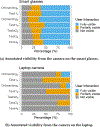From the Lab to People's Home: Lessons from Accessing Blind Participants' Interactions via Smart Glasses in Remote Studies
- PMID: 37942017
- PMCID: PMC10631802
- DOI: 10.1145/3493612.3520448
From the Lab to People's Home: Lessons from Accessing Blind Participants' Interactions via Smart Glasses in Remote Studies
Abstract
Researchers have adopted remote methods, such as online surveys and video conferencing, to overcome challenges in conducting in-person usability testing, such as participation, user representation, and safety. However, remote user evaluation on hardware testbeds is limited, especially for blind participants, as such methods restrict access to observations of user interactions. We employ smart glasses in usability testing with blind people and share our lessons from a case study conducted in blind participants' homes (N = 12), where the experimenter can access participants' activities via dual video conferencing: a third-person view via a laptop camera and a first-person view via smart glasses worn by the participant. We show that smart glasses hold potential for observing participants' interactions with smartphone testbeds remotely; on average 58.7% of the interactions were fully captured via the first-person view compared to 3.7% via the third-person. However, this gain is not uniform across participants as it is susceptible to head movements orienting the ear towards a sound source, which highlights the need for a more inclusive camera form factor. We also share our lessons learned when it comes to dealing with lack of screen reader support in smart glasses, a rapidly draining battery, and Internet connectivity in remote studies with blind participants.
Keywords: blind people; remote method; smart glasses; user study.
Figures





Similar articles
-
Smart glasses for remote assistance: analysing usability and optimal user characteristics among young adults with and without autism.Disabil Rehabil Assist Technol. 2025 Apr 24:1-15. doi: 10.1080/17483107.2025.2494660. Online ahead of print. Disabil Rehabil Assist Technol. 2025. PMID: 40271973
-
Augmented reality training in basic life support with the help of smart glasses. A pilot study.Resusc Plus. 2023 Apr 18;14:100391. doi: 10.1016/j.resplu.2023.100391. eCollection 2023 Jun. Resusc Plus. 2023. PMID: 37128627 Free PMC article.
-
Delivering allied health services to regional and remote participants on the autism spectrum via video-conferencing technology: lessons learned.Rural Remote Health. 2019 Sep;19(3):5358. doi: 10.22605/RRH5358. Epub 2019 Sep 2. Rural Remote Health. 2019. PMID: 31474113
-
Preliminary study of prehospital use of smart glasses.Acute Med Surg. 2022 Nov 1;9(1):e807. doi: 10.1002/ams2.807. eCollection 2022 Jan-Dec. Acute Med Surg. 2022. PMID: 36330311 Free PMC article. Review.
-
Clinical and surgical applications of smart glasses.Technol Health Care. 2015;23(4):381-401. doi: 10.3233/THC-150910. Technol Health Care. 2015. PMID: 26409906 Review.
Cited by
-
Understanding How Blind Users Handle Object Recognition Errors: Strategies and Challenges.ASSETS. 2024;2024:1-15. doi: 10.1145/3663548.3675635. ASSETS. 2024. PMID: 40028444 Free PMC article.
-
Assessing the implementation of user-centred design standards on assistive technology for persons with visual impairments: a systematic review.Front Rehabil Sci. 2023 Sep 6;4:1238158. doi: 10.3389/fresc.2023.1238158. eCollection 2023. Front Rehabil Sci. 2023. PMID: 37744430 Free PMC article. Review.
-
Blind Users Accessing Their Training Images in Teachable Object Recognizers.ASSETS. 2022 Oct;2022:14. doi: 10.1145/3517428.3544824. Epub 2022 Oct 22. ASSETS. 2022. PMID: 36916963 Free PMC article.
References
-
- Ahmetovic Dragan, Bernareggi Cristian, Keller Kristian, and Mascetti Sergio. 2021. MusA: Artwork Accessibility through Augmented Reality for People with Low Vision. Association for Computing Machinery, New York, NY, USA. 10.1145/3430263.3452441 - DOI
-
- Aira. 2021. Assistive Technology for the Blind and Visually Impaired. https://taptapseeapp.com/
-
- Aira. 2021. Connecting you to real people instantly to simplify daily life. https://aira.io/
-
- Akter Taslima, Ahmed Tousif, Kapadia Apu, and Swaminathan Swami Manohar. 2020. Privacy Considerations of the Visually Impaired with Camera Based Assistive Technologies: Misrepresentation, Impropriety, and Fairness. In The 22nd International ACM SIGACCESS Conference on Computers and Accessibility (Virtual Event, Greece) (ASSETS ‘20). Association for Computing Machinery, New York, NY, USA, Article 32, 14 pages. 10.1145/3373625.3417003 - DOI
-
- Shurug Al-Khalifa and Muna Al-Razgan. 2016. Ebsar: Indoor guidance for the visually impaired. Computers & Electrical Engineering 54 (2016), 26–39.
Grants and funding
LinkOut - more resources
Full Text Sources
Miscellaneous
